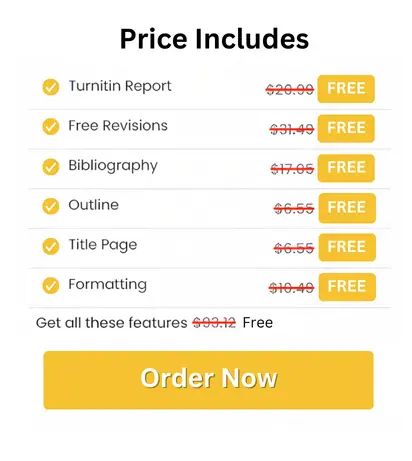
GDECE104 Professional Teaching Practice 1 Report 2 Sample
Assignment Brief
The intention of the observation report is to identify, analyse and assess the children’s area of interest, and use the analysis as a starting point to compose learning experiences or lesson plans. This assessment will examine students understanding of evidence-based learning and how to interpret observations into meaningful and play-based teaching moments to foster children’s learning and development. Therefore, strong connections between observation analysis and children’s area of interest must be addressed.
In analysing the observations, it is essential and expected that students make frequent reference to the relevant learning frameworks to support and form the analysis. Students are also expected to use academic literature and relevant theories to support their assessment of the observation. An effective and accurate use of APA 7th referencing style is also required in this assessment.
Task description:
Following the early years learning framework planning cycle (Australian Government Department of Education [AGDE], 2022), develop 2 lesson plans or learning experiences for children based on assessment of an observation report. Drawing on principles and practices of early childhood pedagogy (AGDE, 2022), plan the learning experiences with emphasis on play-based learning with intentionality, adopting holistic approaches of children’s learning and development.
Task Instruction:
• Do an observation of children’s learning in the video provided, chose 1 of the videos provided below:
1. Connecting with practice: Young toddlers’ learning
2. Connecting with Practice: Marking with coloured pencils
3. Connecting with practice: Discovering- making connections
4. Connecting with Practice: Discovering – making music
• Write an observation report using a particular method of observation (the report is an appendix, not included in word count). Choose one of the following methods of observation (Arthur et al., 2020; Irving & Carter, 2018):
- Running records
- Anecdotes (Anecdotal records)
- Checklists
- Learning stories
- Jottings
- Work samples (artefacts)
- Time samples
- Event samples
- Photographs
• Assess the observation report, using references from documents of learning frameworks (EYLF/VEYLDF/NQF/NQS), theories of children’s learning and development, and a range of relevant research and literature.
• Plan 2 learning experiences (lesson plans) based on assessment and analysis of the observation report.
• Provide rationale that includes critical reflection and justification of the learning experience with focus on play-based learning with intentionality, and holistic approaches of children’s learning and development.
Criteria:
• write an observation report using a particular method of observation and assess the observation report with in-depth analysis.
• Develop 2 lesson plans (student can use provided lesson plan template but welcome to write in paragraphs)
• Each lesson plan should be developed for teaching one topic, for example “colourful shapes”; “colouring monkey”; “vegetable man”; “five fingers”; “a hungry caterpillar” and so on.
• Each lesson plan should be designed with specific learning objectives that can be linked to EYLF.
• Each lesson plan needs to meet children’s learning and development needs (consider age appropriateness and relevance of the experience).
• Each lesson plan should include assessment strategies, learning environment arrangement, safety, and inquiry questions.
Solution
Observation
Thomas noticed an outdoor play activity as he seemed theoretically involved in play involving sounds from manufacturing a musical vibe by the use of wood sticks to various kinds of steel pans and other tools, and the resulting sounds ranged from low-pitched and soft to high-pitched and aggressive, which seemed awesome and savoury to him. Back in the day, Friedrich's mind suddenly kicked in, reflecting on his life (making music). So much had happened in his lifetime. Then he felt this profound satisfaction and started exploring further. There was a truthful exchange of thoughts between him and his peer beside him. Among all the gears and nuts, this girl reacted to this positive contact with the tools and was intrigued enough to investigate and act on it. The inquisitive girl, motivated by the outcome of Thomas's finding, opted to give the activity a shot and included that element that set hers apart. As far as I could see, she was holding a metal triangle beater at first, and she began to copy his behaviour by hitting it against the different items available for noise. There was now a team event instead of a one-person outdoor play activity, as she was busy communicating with the other person, and their jubilation was visible in their reactions as well. The team performed a task that had us determine if a square wire beater would pass through a wooden pipe. The mixer was just right for my purpose and made new noises, making me excited. Unbelievable. Thomas did not only hit the pipes to give the noise more life but what about that disco music that emerged from the thick of nowhere? They spread the word using their inventions of storytelling that would survive the communities (Fernández-Batanero et. al., 2022). Earlier in the play, another guy joined the scene as the guitarist and also a singer, to prove that their social life was not poor and they were willing to have a good collaboration. The play became a band, skillfully played by a boy with a stick for rhythm and a pipe for their microphone for university assignment help.
Analysis
The experience of outdoor play-based learning in early childhood settings is a fundamental interest engine, and children find that discoveries made there are their favourite learning memories. Thomas could be overwhelming one moment, interlacing noises with the rest of the team or performing a solo in confidence. This is the same as some outcomes of EYLF: children being involved and self-assured learners.
Their community experiences of Thomas are a remarkable factor that appears when he engages with a girl and friends and learns how to live together successfully. This action suggests that Vygotsky's sociocultural theory states that children or learners acquire knowledge quickly when they socialize. In revealing their discoveries in shared games, Thomas and his friends not only had social interaction but also important social skills such as negotiating and being friends with others.
Group activities help kids develop their relationships with and their responsibilities to the surrounding world in general and enhance their communication and learning skills. Thomas's collaboration with a range of sounds and sensory activities tended to provide a different level of understanding about his auditory perception as well as improve his sensory processing skills (Sancar et. al., 2022). Along these lines, one can argue about the compatibility of Ayres' sensory integration theory, which points out that sensory-stimulated experiences have a great role in the development of motor skills, cognition, and emotion regulation.
By the end of the video, Thomas, through improvised drumming, demonstrated the main idea: that without the practical basis upon which a theory is built, a theory is only of little value. Through providing a broad spectrum of engaging natural environments, along with conducting free play to activate children's imagination, brimming positivity, a sense of pride, and a bond with their peers, the outcomes of EYLF materialize.
Lesson Plan 1: Nature Sounds Scavenger Hunt
Rationale
This lesson plan has been made to encourage the kids to actively take part in their out-of-doors global while also supporting them in expanding their auditory and sensory focus. This activity inspires interest, recognizing the connection to their nature, and significant mastering studies through outdoor exploration and sensory reports, along with collaboration with peers, which aligns with the EYLF results of children being powerful and assured newbies. Through the satisfaction of most of these effects, this interest gives a more holistic development to the youngsters worried.
Learning Objectives
This interest pursuit seeks to apply sounds to get the youngsters engaged in exploring their outside environment by providing them with an interesting experience. This caters to outcome 2 of the EYLF imparting them with the possibility to explore actively and their connection to the environment, as this will help them better recognize nature around them and participate in a significant mastering revel in. This pastime also targets their social and communicative abilities because it calls for them to work in teams (Bragg et. al., 2021). This pastime aims to provide holistic development for children.
Required Materials
? Clipboards
? Paper
? Pencils and crayons
? Recording Device or Telephone with a Voice Recording App
Implementation of Activity
? Introduction: I will collect the kids and get them to form a circle to get their attention, after which I'll introduce the idea of a nature scavenger hunt to them. In this technique, I'd talk with them about the sounds they could hear while we were out in nature, like birds chirping, leaves rustling, and the sound of water flowing.
? Nature walk: I might then proceed to take the children on a walk around the selected out-of-door surroundings while getting the youngsters to interact in the interest using encouraging them to pay attention carefully to the noises around them and getting them to identify those noises. I might then deliver the youngsters with clipboards for them to observe the sounds they become aware of or make drawings of the surroundings they see.
? Scavenger Hunt: Now I'd divide the kids into groups of four with an educator to supervise and assist every organization, and offer them each a listing of sounds for them to listen to and tick off. This might encourage kids to apply their sense of listening to assist them in identifying and finding these sounds in their scavenger hunt listing. Each group would also be furnished with a pair of binoculars to help them discover the sounds. And those sounds could be recorded.
? Reflection: Finally, the youngsters would be gathered to reflect on their experiences and discuss the sounds they identified for the duration of the search.
Lesson Plan 2: Building a Sound Symphony
Rationale
This lesson plan is mapped out to help kids collaborate, talk, and express themselves via tune to construct upon their interest in the exploration of sound as determined (Bahodirovich and Romilovich, 2021). This interest builds on the EYLF final results of children being powerful communicators through social interaction and collaboration through play-based experiences.
Learning Objectives
At the centre of this pastime is the purpose for children to collaborate and paint collectively to decorate their social talents to create a musical composition. This additionally enables them to broaden their sensory and auditory processing capabilities through this attractive interest, which satisfies the EYLF outcome of youngsters being linked to and making a contribution to the world around them.
Resources Required
? Musical Gadgets
? Normal Objects: Pots and Pans, Cloth Scraps, Bubble Wrap
Activity Implementation
? Introduction: I might introduce the idea of building a valid symphony to the youngsters while discussing the sounds exclusive musical instruments make.
? Sound exploration stations: I might install five unique stations with quite a few substances and units that create sounds, and then I'd split the children into groups and engage them in exploring and experimenting with special materials at these stations.
? Collaborative composition: I might now get the children to use the stories they received through the sound stations for them to paint collectively and combine the sounds they discovered to make a tune composition.
? Rehearsal and performance: I might now exercise this composition made as a group and make the changes, and then get the children to carry out their composition in every other class and document it for future reference (Murkatik et. al., 2020).
? Reflection: I would now get the youngsters to talk about their perspectives on the way the technique of making the composition went.
Conclusion
Thomas, an early childhood learner, participated in an outdoor play-based learning activity that created a musical atmosphere using wood sticks and steel pans. This activity sparked curiosity and led to further exploration and collaboration among the children. The experience of outdoor play-based learning in early childhood settings is a fundamental interest engine, and children find these discoveries to be their favourite learning memories. Early Years Learning (EYLF) benefits children by fostering self-assurance and social skill development. Group activities help kids develop relationships, responsibilities, and communication and learning skills. Thomas's collaboration with various sounds and sensory activities improved his auditory perception and sensory processing skills, aligning with Ayres' sensory integration theory. The lesson plan encourages children to actively participate in their outdoor environment, expanding their auditory and sensory focus and fostering a connection to nature. The lesson plan also includes building a sound symphony, introducing the idea, installing sound exploration stations, using stories, performing the composition, and reflecting on their perspectives
Reference
Bahodirovich, O. J., and Romilovich, B. R. (2021). Project for training professional skills for future teachers of technological education. Mental Enlightenment Scientific-Methodological Journal, 139–150. http://mentaljournal-jspu.uz/index.php/mesmj/article/download/88/86
Bragg, L. A., Walsh, C., and Heyeres, M. (2021). Successful design and delivery of online professional development for teachers: A systematic review of the literature. Computers and Education, 166, 104158. https://www.academia.edu/download/65731957/1_s2.0_S036013152100035X_main.pdf
Fernández-Batanero, J. M., Montenegro-Rueda, M., Fernández-Cerero, J., and García-Martínez, I. (2022). Digital competencies for teacher professional development. Systematic review. European Journal of Teacher Education, 45(4), 513-531. https://idus.us.es/bitstream/handle/11441/102445/Digital%20competences%20for%20teacher%20professional
%20development.%20Systematic%20review.pdf?sequence=1
Making Music. Connecting with practice: discovering and making music. [online] www.youtube.com. Available at: https://www.youtube.com/watch?v=EXS4aadhNoQ&t=8s.
Murkatik, K., Harapan, E., and Wardiah, D. (2020). The influence of professional and pedagogic competence on teachers's performance. Journal of Social Work and Science Education, 1(1), 58–69. http://ejournal.karinosseff.org/index.php/jswse/article/download/10/10
Sancar, R., Atal, D., and Deryakulu, D. (2021). A new framework for teachers’ professional development. Teaching and teacher education, 101, 103305. https://www.sciencedirect.com/science/article/pii/S0742051X21000299




 81 Isla Avenue Glenroy, Mel, VIC, 3046 AU
81 Isla Avenue Glenroy, Mel, VIC, 3046 AU



